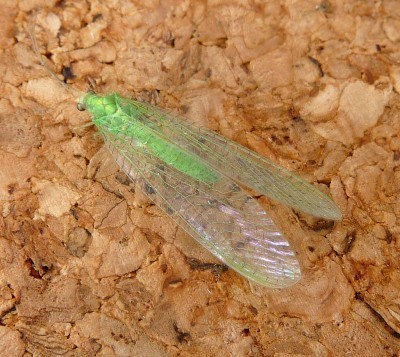






Every gardener knows the jolly, rotund ladybug as a friend in the battle against bugs. Fewer recognize green lacewings in the garden, although they provide just as much help to a gardener seeking a chemical-free solution to insect pests. Like the ladybug, lacewing beneficial insects will be your best gardening pals if you put aside broad spectrum pesticide use and let them hunt unhindered on your plants.
Green lacewings are insect predators that measure ½ to ¾ of an inch long and bear very distinctive, delicate-looking wings that give them their names. These green insects have long antennae and gold or copper eyes.
Many different species of green lacewings exist, but they closely resemble one another. Their larvae are flattened, with an alligator-like appearance and reach up to ½ inch in length.
Green lacewings are generalist predators, meaning that they aren’t picky eaters and will prey on a wide range of pests. Common targets include:
Green lacewings also frequently feed on insect eggs, plant nectars, pollen and honeydew. Larval lacewings are insatiable predators – eating over 200 prey insects each week!
Using lacewings for insect control is a common practice in home gardens and greenhouses. They often appear on their own after the spring breeding season, when green lacewings scatter far and wide to lay their eggs. Watch for little eggs hanging from thin, thread-like spindles on the undersides of plant leaves – these distinctive eggs belong to the green lacewing.
You can encourage green lacewings to stick around by discontinuing the use of broad-spectrum pesticides. These chemicals often ravage beneficial insect populations, creating room for pest insects to multiply. When pesticides must be used, try those that target a specific group of pests, like Bacillus thuringiensis, a stomach poison that only works on caterpillars and maggots.
Having green lacewings in your garden won’t guarantee that your plants never experience pest feeding. In fact, if these pests are totally eliminated, the lacewings will go elsewhere in search of hunting spots. Be prepared to see a few bugs now and again; just monitor regularly to make sure they don’t reach damaging numbers before your lacewings get a handle on things.
What Are The Important Tips For Swimming Pool Leak Repair?
What Are Herbicide Adjuvants: Herbicide Adjuvant Guide For Gardeners
What Are Garden Gnomes: Uses For Garden Gnomes In The Landscape
Cheesecloth Fabric: Tips For Using Cheesecloth In The Garden
Copyright © www.100flowers.win Botanic Garden All Rights Reserved